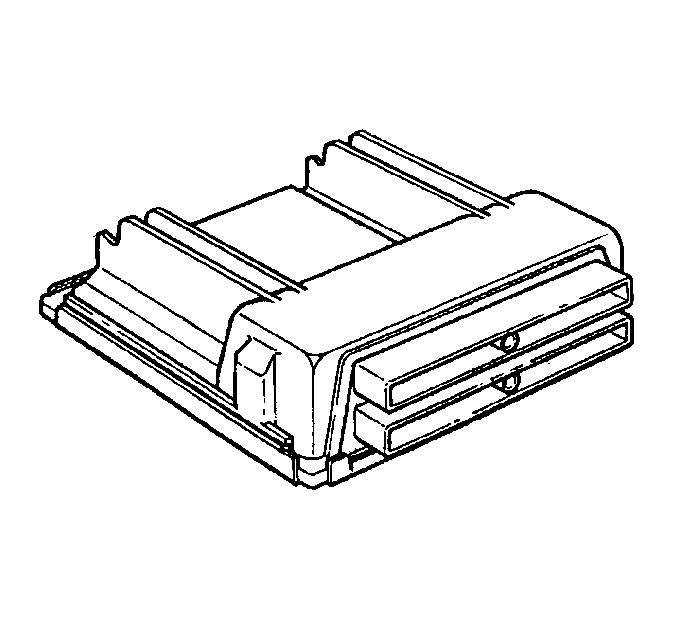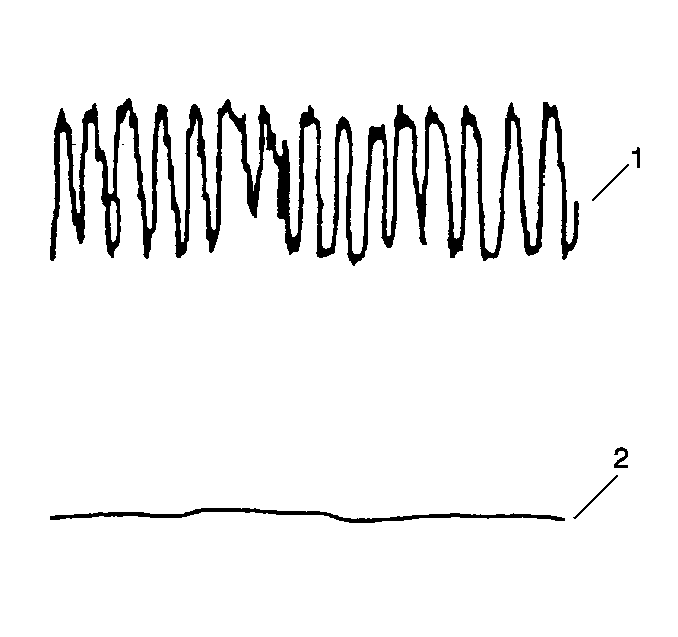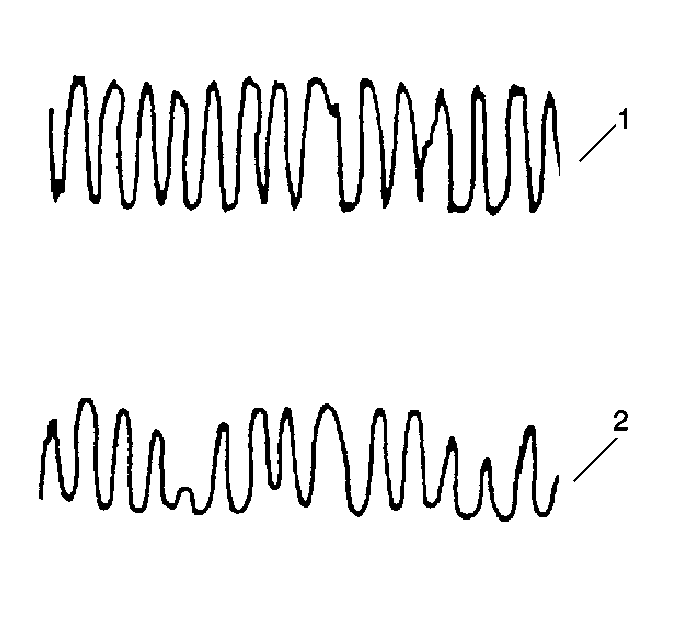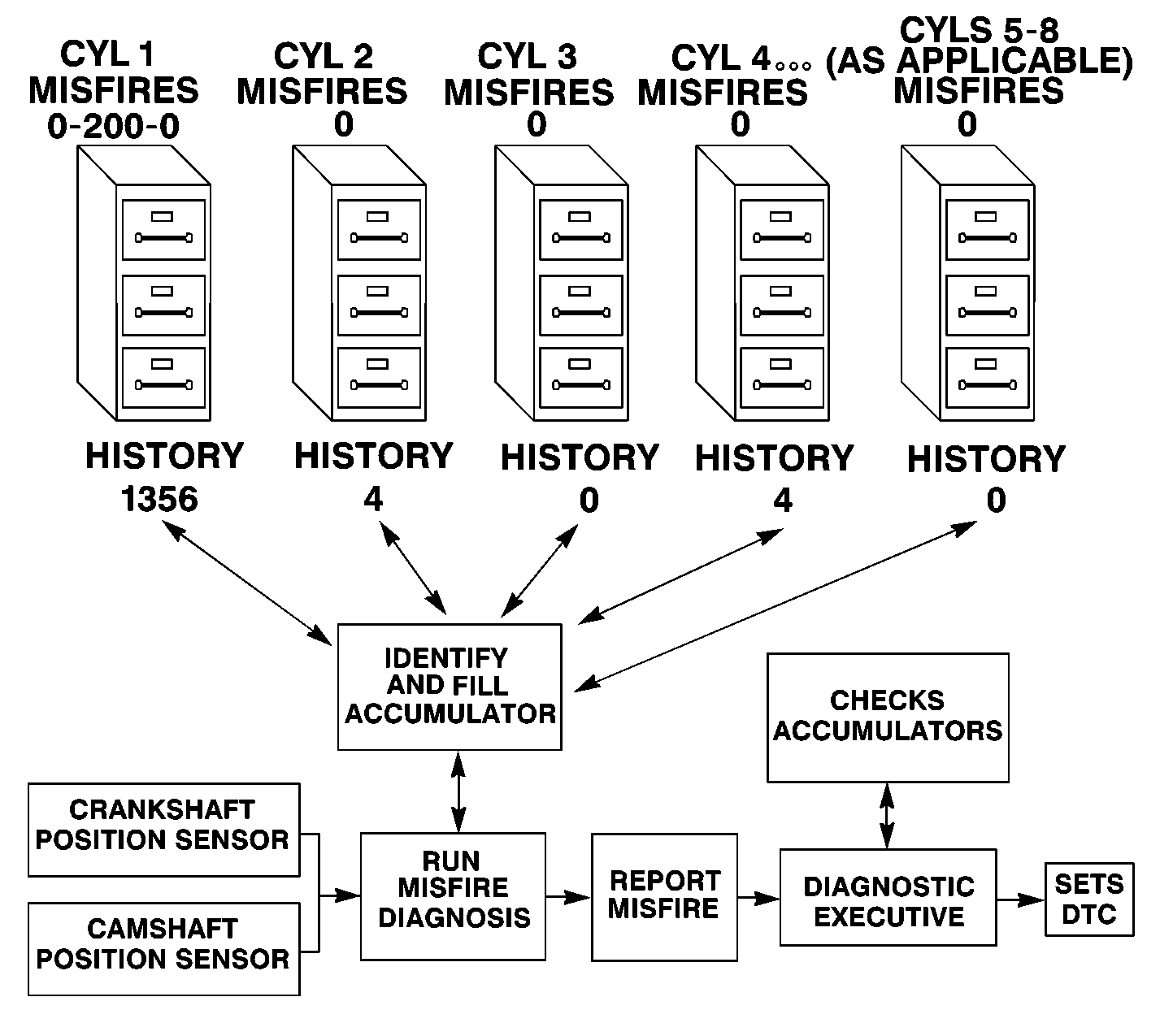The Powertrain Control Module (PCM) is designed to maintain
exhaust emission levels while maintaining excellent driveability and fuel
efficiency. The PCM controls the following operations:
| • | Knock Sensor (KS) system |
| • | Automatic transmission shift functions |
| • | Manual transmission: 1-4 Upshift and Reverse Inhibit |
| • | Cruise Control Enable (if so equipped) |
| • | Evaporative Emission (EVAP) Purge |
| • | Secondary Air Injection (AIR) |
| • | Exhaust Gas Recirculation (EGR) |
| • | On-board diagnostics for powertrain functions. |
Powertrain Control Module

The Powertrain Control Module (PCM) is located in the engine
compartment. The PCM is the control center of the vehicle.
The PCM constantly monitors the information from various sensors and
controls the systems that affect vehicle performance and emissions. The PCM
also performs the diagnostic functions for those systems. It
can recognize operational problems and will alert the driver through
the MIL (Malfunction Indicator Lamp) when a malfunction has occurred.
When the PCM detects a malfunction, it stores a diagnostic trouble
code (DTC) which will help identify problem areas. This is done
to aid the technician in making repairs.
The PCM supplies either 5.0 or 12.0 volts to power
various sensors or switches. This is done through resistances in the PCM.
The resistance is so high in value that a test lamp will not illuminate
when connected to the circuit. In some cases, even an ordinary
shop voltmeter will not give an accurate reading because its resistance
is too low. Therefore, a digital voltmeter (J 39200) with
a minimum of 10 megaohms input impedance is required to
ensure accurate voltage readings.
The PCM controls output circuits such as the injectors, IAC, cooling
fan relays, etc. by controlling the ground or the power feed circuit through
transistors or a device called an Output Driver Module.
Torque Management
Torque Management is a function of the PCM that reduces engine power
under certain conditions. Torque Management is performed for the following
reasons:
| • | To prevent over stressing the powertrain components. |
| • | To prevent damage to the vehicle during certain abusive maneuvers. |
| • | To reduce engine speed when the IAC is out of the normal operating
range. |
The PCM monitors the following sensors and engine parameters to calculate
engine output torque:
| • | Manifold Absolute Pressure |
| • | Engine Coolant Temperature |
The PCM monitors the torque converter status, the transmission gear
ratio, and the engine speed in order to determine if torque reduction is
required. The PCM retards the spark as appropriate to reduce engine
torque output if torque reduction is required. The PCM also shuts
off the fuel to certain injectors to reduce the engine power In
the case of an abusive maneuver.
The following are instances when engine power reduction is likely to
be experienced:
| • | During transmission upshifts and downshifts. |
| • | Heavy acceleration from a standing start. |
| • | The IAC is out of the normal operating range. |
| • | When the driver is performing harsh or abusive maneuvers such
as shifting into gear at high throttle angles or shifting the transmission
from reverse to drive to create a rocking motion. |
The driver is unlikely to notice the torque management actions in the
first two instances. The engine power output will be moderate at full throttle
in the other two cases.
The PCM calculates the amount of spark retard necessary to reduce the
engine power by the desired amount. The PCM disables the fuel injectors for
cylinders 1, 4, 6, and 7 in the case of an abusive maneuver.
PCM Function
The PCM supplies a buffered voltage to various sensors and switches.
The PCM controls most components with electronic switches which complete a
ground circuit when turned ON.
PCM Service Precautions
The PCM is designed to withstand normal current draws associated with
vehicle operations. Avoid overloading any circuit. When testing for opens
or shorts, do not ground any of the PCM circuits unless instructed.
When testing for opens or shorts, do not apply voltage to
any of the PCM circuits unless instructed. Test these circuits
with a digital voltmeter J 39200
only, while the PCM connectors remain connected.
Aftermarket (Add-On) Electrical And Vacuum Equipment
Aftermarket (Add-On) Electrical and Vacuum Equipment is defined as any
equipment installed on a vehicle after leaving the factory that connects to
the vehicle's electrical or vacuum systems. No allowances
have been made in the vehicle design for this type of equipment.
Notice: Do not attach add-on vacuum operated equipment to this vehicle. The
use of add-on vacuum equipment may result in damage to vehicle components
or systems.
Notice: Connect any add-on electrically operated equipment to the vehicle's
electrical system at the battery (power and ground) in order to prevent damage
to the vehicle.
Add-On electrical equipment, even when installed to these strict guidelines,
may still cause the Powertrain system to malfunction. This may also include
equipment not connected to the vehicle's electrical system
such as portable telephones and radios. Therefore, the first
step in diagnosing any Powertrain problem is to eliminate
all aftermarket electrical equipment from the vehicle. After
this is done, if the problem still exists, diagnose the problem
in the normal manner.
Engine Controls Information
The driveability and emissions information describes the function and
operation of the PCM.
The engine controls Information contains the following:
| • | PCM Terminal End View and Terminal Definitions |
| • | Powertrain On-Board Diagnostic (OBD) System Check |
| • | Diagnostic Trouble Code Tables (DTCs) |
The Component System includes the following items:
| • | Component and circuit description |
| • | On-vehicle service for each sub-system |
| • | Functional checks and Diagnostic Tables |
The DTCs also contain diagnostic support information containing circuit
diagrams, circuit or system information, and helpful diagnostic information.
Maintenance Schedule
Refer to the General Motors Maintenance Schedule of the appropriate
service category for the maintenance that the owner or technician should perform
in order to retain emission control performance.
Visual and Physical Underhood Inspection
Perform a careful visual and physical underhood inspection when performing
any diagnostic procedure or diagnosing the cause of an emission test failure.
This can often lead to repairing a problem without further
steps. Use the following guidelines when performing a visual
and physical inspection:
| • | Inspect all vacuum hoses for the following conditions: |
| • | Inspect all wires in the engine compartment for the following
items: |
| - | Contact with sharp edges |
| - | Contact with hot exhaust manifolds |
This visual and physical inspection is very important. Preform the inspection
carefully and thoroughly.
System Status and Drive Cycle For Inspection/Maintenance
The System Status selection is included in the scan tool System Info
menu.
Several states require that the I/M (OBD ll system) pass on-board tests
for the major diagnostics prior to having a vehicle emission inspection. This
is also a requirement to renew license plates in some areas.
Using a scan tool, the technician can observe the System Status (complete
or not complete) in order to verify that the vehicle meets the criteria to
comply with local area requirements. Using the System Status
display, any of the following systems or combination of systems
may be monitored for I/M Readiness:
Important: The System Status display indicates only whether or not the test has
been completed. The System Status display does not necessarily mean that the
test has passed. If a Failed Last Test indication is present
for a DTC associated with one of the above systems, diagnosis
and repair is necessary in order to meet the I/M requirement.
Verify that the vehicle passes all of the diagnostic tests
associated with the displayed System Status prior to returning
the vehicle to the customer. Refer to the Typical Drive Cycle
table (more than one drive cycle may be needed) to use as
a guide to complete the I/M System Status tests.
Following a DTC info clear, System Status will clear for one or all
of these systems. Following a battery disconnect or a PCM replacement, all
System Status information will clear.
Typical Drive Cycle
Diagnostic Time Schedule for I/M Readiness
|
Vehicle Drive
Status
| What is Monitored?
|
Cold Start,
coolant temperature less than 50°C (122°F)
| --
|
Idle 2.5 minutes
in Drive (Auto) Neutral (Man), A/C and rear defogger ON
| HO2S Heater, Misfire,
Secondary Air, Fuel Trim, EVAP Purge
|
A/C off, accelerate to 90 km/h
(55 mph), 1/2 throttle.
| Misfire, Fuel Trim, Purge
|
3 minutes
of Steady State - Cruise at 90 km/h (55 mph)
| Misfire, EGR,
Secondary Air, Fuel Trim, HO2S, EVAP Purge
|
Clutch engaged (Man),
no braking, decelerate to 32 km/h (20 mph)
| EGR, Fuel Trim, EVAP
Purge
|
Accelerate to 90-97 km/h (55-60 mph),
3/4 throttle
| Misfire, Fuel Trim, EVAP Purge
|
5 minutes of Steady State Cruise
at 90-97 km/h (55-60 mph)
| Catalyst Monitor, Misfire, EGR,
Fuel Trim, HO2S, EVAP Purge
|
Decelerate, no braking. End of Drive Cycle
| EGR, EVAP Purge
|
Total time of OBD II Drive Cycle 12 minutes
| --
|
Primary System Based Diagnostics
There are primary system-based diagnostics which evaluate the system
operation and their effect on vehicle emissions. The primary system-based
diagnostics are listed below, with a brief description of the
diagnostic functionality.
Oxygen Sensor Diagnosis
Diagnose the Fuel Control Heated Oxygen Sensors for the following conditions:
| • | Heater Performance (time to activity on cold start) |
| • | Response Time (time to switch R/L or L/R) |
| • | Inactive Signal (output steady at bias voltage - approximately
450 mV) |
Diagnose the Catalyst Monitor Heated Oxygen Sensors for the following
functions:
| • | Heater Performance (time to activity on cold start) |
| • | Signal fixed low during steady state conditions. |
Heated Oxygen Sensors (Pre-Catalyst)
The main function of the Pre-Catalyst Heated Oxygen Sensor (HO2S) is
to provide the PCM with exhaust stream information in order to maintain
proper fueling to hold emissions within acceptable levels. These oxygen
sensors are always located between the exhaust manifold and the catalytic
converter. After the sensor reaches the operating temperature,
the sensor generates a voltage inversely proportional to the
amount of oxygen present in the exhaust gases.
The PCM uses the signal voltage from the fuel control heated oxygen
sensors in a closed loop in order to adjust the fuel injector pulse width.
While in a closed loop, the PCM can adjust fuel delivery in order
to maintain an air to fuel ratio which allows the best combination
of emission control and driveability.
If the oxygen sensor pigtail wiring, connector or terminal are damaged,
replace the entire oxygen sensor assembly. Do not attempt to repair the wiring,
connector, or terminals. In order for the sensor to function
properly, the sensor must have a clean air reference provided
to it. This clean air reference is obtained by way of the oxygen
sensor wires. Any attempt to repair the wires, connectors or
terminals could result in the obstruction of the air reference.
Any attempt to repair the wires, connectors or terminals would
degrade oxygen sensor performance.
Catalyst Monitor Heated Oxygen Sensors
In order to control emissions of Hydrocarbons (HC), Carbon Monoxide
(CO), and Oxides of Nitrogen (NOx), the system uses a three-way catalytic
converter. The catalyst promotes a chemical reaction which
oxidizes the HC and CO present in the exhaust gas, converting them
into harmless water vapor and carbon dioxide. The catalyst also
reduces NOx, converting it to nitrogen. Catalyst Monitor HO2S
( Post Catalyst HO2S) are always located downstream of the catalytic
converter.
The PCM has the ability to monitor this process using the post catalyst
heated oxygen sensors. The pre-sensors produce an output signal which indicates
the amount of oxygen present in the exhaust gas entering the
three-way catalytic converter. The post sensor produces an output
signal which indicates the oxygen storage capacity of the catalyst.
This in turn indicates the catalyst's ability to convert exhaust
gases efficiently. If the catalyst is operating efficiently,
the pre HO2S signal will be far more active than that produced
by the post HO2S.
In addition to catalyst monitoring, the post heated oxygen sensor has
a limited role in controlling fuel delivery. If the post HO2S signal indicates
a high or low oxygen content for an extended period of time while
in a closed loop, the PCM adjusts the fuel delivery slightly
in order to compensate.
Catalyst Monitor Diagnostic Operation
The catalyst monitor diagnostic measures oxygen storage capacity of
the catalyst converter. In order to do this, the heated sensors are installed
before and after the Three-Way Catalyst (TWC). Voltage variations
between the sensors allow the PCM to determine the catalyst emission
performance.
As a catalyst becomes less effective in promoting chemical reactions,
the catalyst's capacity to store and release oxygen generally degrades. The
catalyst monitor diagnostic is based on a correlation between
conversion efficiency and oxygen storage capacity.
A good catalyst (e.g. 95% hydrocarbon conversion efficiency) shows a
relatively flat output voltage on the post-catalyst heated oxygen sensor (HO2S)
signal circuit. A degraded catalyst (65% hydrocarbon conversion)
shows a greatly increased activity in output voltage from the
post catalyst HO2S.
The post-catalyst HO2S is used to measure the oxygen storage and release
capacity of the catalyst. A high oxygen storage capacity indicates a good
catalyst. Low oxygen storage capacity indicates a failing catalyst.
The TWC and the HO2S must be at operating temperature in order
to achieve reliable oxygen sensor voltages like those shown in
the Three-Way Catalyst Oxygen Storage Capacity graphic.
The PCM performs the catalyst diagnostic at idle when the conditions
for running the diagnostic are met. Refer to Conditions for Running the DTC
in
DTC P0420 Catalyst System Low Efficiency Bank 1
or
DTC P0430 Catalyst System Low Efficiency Bank 2
. During the catalyst diagnostic the
PCM captures the current rear HO2S rich/lean status. The Air Fuel ratio
transitions from rich to lean or lean to rich depending on the initial
captured rich/lean status. The Air Fuel ratio transitions a second time
opposite the first Air Fuel ratio transition. During this diagnostic
the scan tool will display HO2S voltages going from full rich to full
lean. This condition is normal during this diagnostic.
The catalyst monitor diagnostic is sensitive to the following conditions:
| • | Alternative fuels (Ethanols and Methanols) |
Exhaust system leaks may cause the following:
| • | Prevent a degraded catalyst from failing the diagnostic |
| • | Cause a false failure for a normally functioning catalyst |
| • | Prevent the diagnostic from running |
Some of the contaminants that may be encountered are phosphorus, lead,
silica, and sulfur. The presence of any of these contaminants will reduce
catalyst efficiency and lead to emission failures.
Three-Way Catalyst Oxygen Storage Capacity

The PCM must monitor the
Three-Way Catalyst system (TWC) for efficiency. In order to accomplish this,
the PCM monitors the pre-catalyst and post-catalyst oxygen
sensors. When the TWC is operating properly, the post-catalyst
(2) oxygen sensor will have significantly less activity than
the pre-catalyst (1) oxygen sensor. The TWC stores oxygen
during its normal reduction and oxidation process. The TWC
releases oxygen during its normal reduction and oxidation process.
The PCM calculates the oxygen storage capacity using the difference
between the pre-catalyst and post-catalyst oxygen sensor's
voltage levels.

Whenever the sensor activity of the post-catalyst (2) oxygen sensor
nears the sensor activity of the pre-catalyst (1) oxygen sensor, the catalysts
efficiency is degraded.
Aftermarket HO2S characteristics may be different from the original
equipment manufacturer sensor. This may lead to a false pass or a false fail
of the catalyst monitor diagnostic. Similarly, if an aftermarket
catalyst does not contain the same amount of precious metal
content as the original part, the correlation between oxygen
storage and conversion efficiency may be altered enough to
set a false DTC.
Misfire Monitor Diagnostic Operation
The misfire monitor diagnostic is based on crankshaft rotational velocity
(reference period) variations. The PCM determines crankshaft rotational velocity
using the crankshaft position sensor and camshaft position
sensor. When a cylinder misfires the crankshaft slows down
momentarily. By monitoring the crankshaft and camshaft position
sensor signals, the PCM can calculate when a misfire occurs.
For a non-catalyst damaging misfire, the diagnostic is required to monitor
a misfire present for between 1000-3200 engine revolutions.
For catalyst damage misfire, the diagnostic responds to the misfire
within 200 engine revolutions.
Rough roads may cause false misfire detection. A rough road applies
sudden torque variations to the drive wheels and drivetrain. This torque can
intermittently decrease the crankshaft rotational velocity. The
ABS system detects uneven speed between the vehicles wheels and sends
data via the serial data bus to the PCM to disable the misfire monitor
until the rough road is no longer detected.
On automatic transmission equipped vehicles, the Torque Converter Clutch
(TCC) will disable whenever a misfire is detected. Disabling the TCC isolates
the engine from the rest of the drive line and minimizes the
effect of the drive wheel inputs on crankshaft rotation.
When the TCC is disabled as a result of misfire detection, the TCC will
re-enabled after approximately 3200 engine revolutions if no misfire
is detected. The TCC remains disabled whenever the misfire is detected,
with or without a DTC set. This allows the misfire diagnostic
to reevaluate the system.

Whenever a cylinder misfires,
the misfire diagnostic counts the misfire and notes the crankshaft position
at the time the misfire occurred.
A current and a history misfire counter is maintained for each cylinder.
The misfire current counters (Misfire Cur #1 - 8) indicate the number of firing
events out of the last 200 cylinder firing events which were
misfires. The misfire current counters displays real time
data without a misfire DTC stored. The misfire history counters
(Misfire Hist #1 - 8) indicate the total number of cylinder
firing events which were misfires. The misfire history counters
displays 0 until the misfire diagnostic has failed and a DTC
P0300 is set. Once the misfire DTC sets, the misfire history
counters will be updated every 200 cylinder firing events.
The Misfire counters graphic illustrates how these misfire counters
are maintained.
When crankshaft rotation is erratic, the PCM detects a misfire condition.
Because of this erratic condition, the data that is collected by the diagnostic
can sometimes incorrectly identify which cylinder is misfiring.
The Misfire Counters graphic shows there are misfires counted
from more than one cylinder. Cylinder #1 has the majority of
counted misfires. In this case, the Misfire Counters would identify
cylinder #1 as the misfiring cylinder. The misfires in the other
counters were just background noise caused by the erratic rotation
of the crankshaft. If the number of accumulated misfires is sufficient
for the diagnostic to identify a true misfire, the diagnostic
will set DTC P0300 - Misfire Detected. The illustration depicts
an accumulation in the history buffers.
If two cylinders in sequential firing order are both misfiring, the
first misfiring cylinder will accumulate misfires in its buffer but the second
misfiring cylinder will not. This is because the PCM compares a misfiring
cylinder with the cylinder 90 degrees prior to it in the firing order.
Therefore the PCM would be comparing crankshaft speed of the second
misfiring cylinder to an already suspect cylinder. The PCM however,
will be able to detect both misfiring cylinders after the engine
exceeds 2000 RPM. This is because the PCM then starts to compare
misfires to the opposing cylinder rather than the previous cylinder
in the firing order.
Use Techline equipment to monitor the misfire counter data on applicable
vehicles. Knowing which specific cylinder(s) misfire can lead to the root
cause. Using the information in the misfire counters, will
identify which cylinder(s) are misfiring. If the counters
indicate cylinders number 1 and 4 misfired, look for a circuit
or component common to both cylinders.
The misfire diagnostic may indicate a fault due to a temporary fault
not necessarily caused by a vehicle emission system malfunction. Examples
include the following items:
| • | Fuel fouled spark plugs |
Fuel Trim System Operation
The Fuel Trim system monitors the averages of short-term and long-term
fuel trim values. If these fuel trim values stay at their limits for a calibrated
period of time, a malfunction is indicated. The fuel trim
diagnostic compares the average of short and long-term fuel
trim values. If either value is within the thresholds, a
pass is recorded. If either value is outside the thresholds,
a rich or lean fuel Trim DTC will set.
Comprehensive Component Monitor Diagnostic
Comprehensive component monitoring diagnostics are required to monitor
emissions-related input and output Powertrain components.
Input Components
The PCM monitors the input components for circuit continuity and out-of-range
values. This includes performance checking. Performance checking refers to
indicating a fault when the signal from a sensor does not
seem reasonable (i.e. a Throttle Position (TP) sensor that
indicates high throttle position at low engine loads or
MAP voltage). The input components may include but are
not limited to the following sensors:
| • | The Vehicle Speed (VSS) sensor |
| • | The Accelerator Pedal Position (APP) sensor (if so equipped) |
| • | Mass Air Flow (MAF) sensor |
| • | Intake Air Temperature (IAT) sensor |
| • | Crankshaft Position (CKP) sensor |
| • | Throttle Position (TP) sensor |
| • | Engine Coolant Temperature (ECT) sensor |
| • | Camshaft Position (CMP) sensor |
| • | Manifold Absolute Pressure (MAP) sensor |
In addition to the circuit continuity and rationality check, the ECT
sensor is monitored for its ability to achieve a steady state temperature
to enable closed loop fuel control.
Output Components
Diagnose the output components for the proper response to PCM commands.
Components where functional monitoring is not feasible will be monitored for
circuit continuity and out-of-range values if applicable.
Output components to be monitored include, but are not limited to the
following circuits:
| • | Idle Air Control (IAC) Motor |
| • | Electronic transmission controls |
| • | Cruise control inhibit (if so equipped) |




